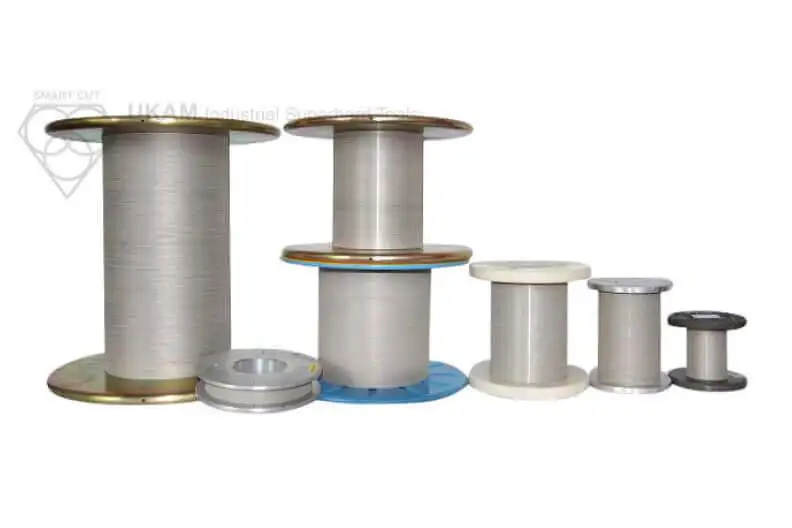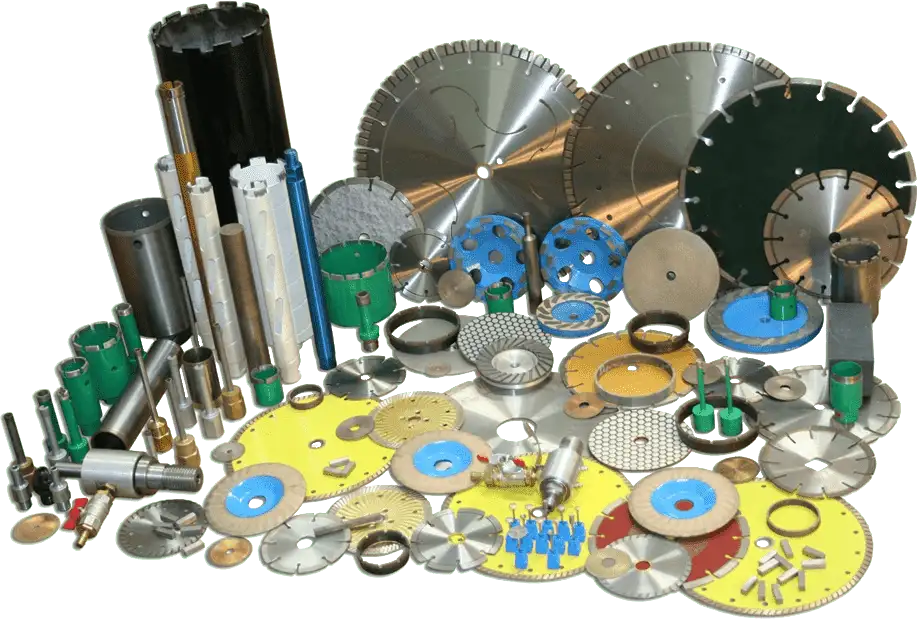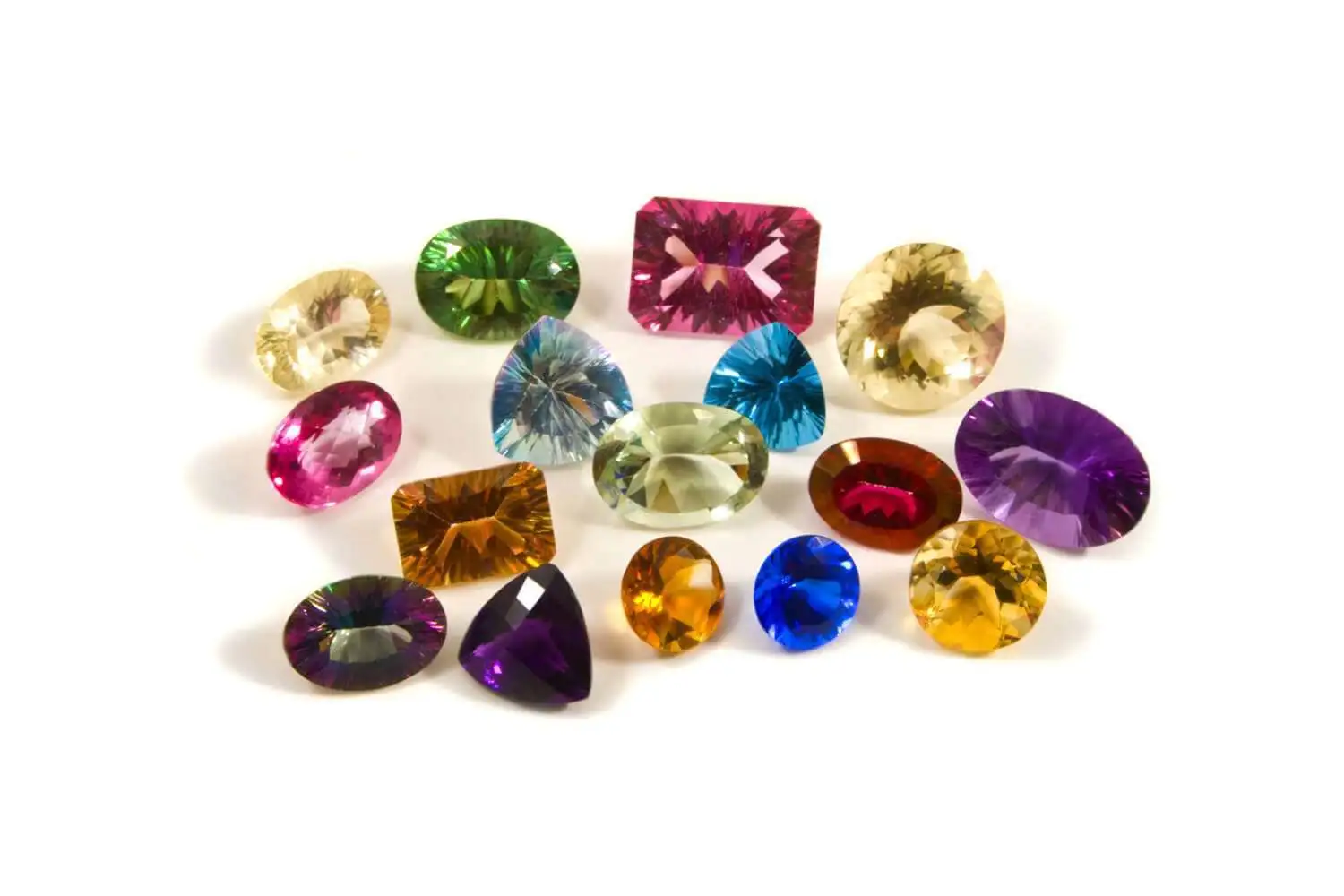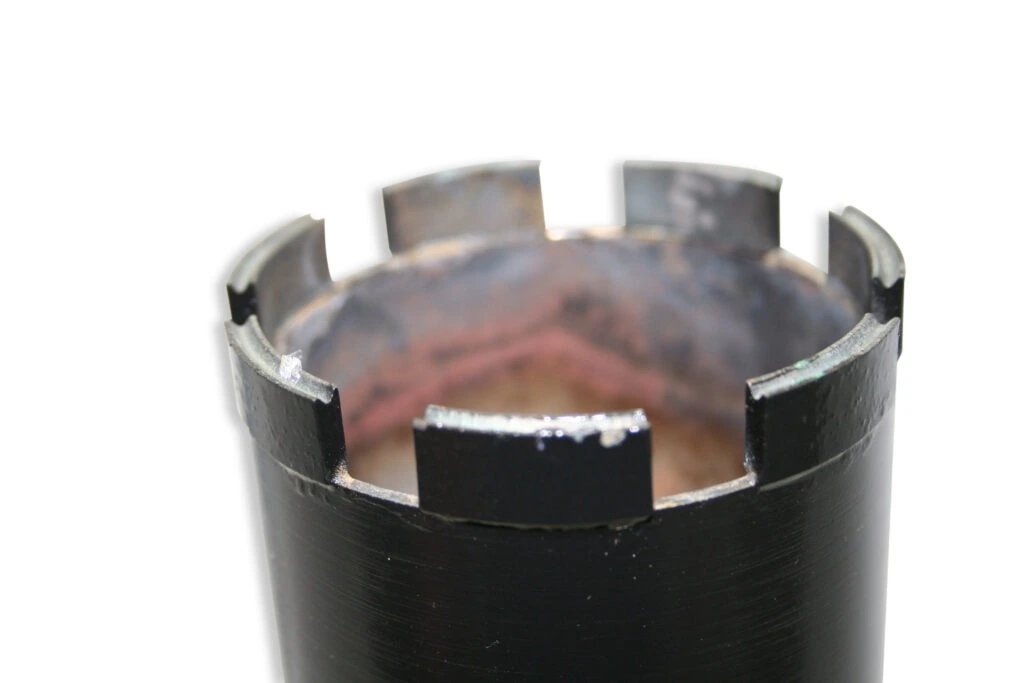-
0 items in quote
No products in the Quote Basket.
Dry Diamond Core Bits for Masonry & Concrete (dry / wet)
DRILL ALL TYPE OF MASONRY AND CONCRETE MATERIALS FAST & EASY
For wet / dry drilling. 9″ tube length with laser-welded individual segments to hold up under extreme heat and cutting pressure. Barrel vents increase air flow to dissipate heat and cool the core bit. Specially formulated professional quality segments provide fast cutting and long life in a variety of materials including concrete, reinforced concrete, brick, block and masonry. Full range of sizes for virtually any job. Use on core drilling machines and hand-held drills. Core Bit intended for Concrete with light to moderate reinforcement, Masonry, Block and Brick. Can be used Dry or Wet
DESCRIPTION
ADVANTAGES
INDUSTRIES USED IN
FAQ
ACCESSORIES
USAGE RECOMMENDATION
DESCRIPTION
Eliminate unsightly hammer drill blowouts and slow chisel work …. cut up to 9-inches deep and more through brick and cement block. Save valuable time and money with these efficient work tools that eliminate unsightly patch jobs.
Bits are designed for fast penetration and are extremely cost effective. Not recommended for use on reinforced and prestressed concrete.
SMART CUT® Dry Diamond Core Bits utilize State of the Art Laser welding for superior bonding strength able to withstand heat generated from dry drilling. These hole saws may either be used with a non-percussion type drill or a hand-held grinder equipped with 5/8″-11 threads for direct connection. Other drills fitted with a 3/8-inch 3-jaw chuck require our 3/8″ or 1/2″ Shank Adaptor required to mount any of the core bits listed below.
ADVANTAGES
- LONGER LASTING
- FAST DRILLING
- Manufactured with SMART CUT technology
- Best Performance & Value for your money
- Super Long Life / Consistent Performance
- Works on large variety of brick, block, masonry, and softer concrete materials
- More Aggressive
- Smoother Finish
- Easy to Use
- Works on all Popular Drilling Equipment
INDUSTRIES USED IN





FAQ
Dry Diamond Core Bits are specialized drilling tools designed for masonry and concrete materials. They can be used for both dry and wet drilling. These bits are manufactured using SMART CUT® technology, ensuring high performance and durability.
- Dual Use: Suitable for both dry and wet drilling.
- Design: 9″ tube length with laser-welded segments for durability.
- Heat Management: Barrel vents to dissipate heat.
- Material Compatibility: Ideal for concrete, reinforced concrete, brick, block, and masonry.
- Size Range: Available in various sizes for different applications.
- Compatibility: Can be used with core drilling machines and hand-held drills.
- Longevity: Designed for longer-lasting use.
- Fast Drilling: Engineered for quick penetration into materials.
- Versatility: Works effectively on a wide range of masonry and concrete materials.
- Smooth Finish: Ensures a cleaner and smoother finish.
- User-Friendly: Easy to handle and compatible with popular drilling equipment.
They are not recommended for use on heavily reinforced or prestressed concrete due to their specific design and material compatibility.
SMART CUT® technology refers to the state-of-the-art laser welding process used in these core bits, providing superior bonding strength and heat resistance during dry drilling.
They can be used with non-percussion type drills or hand-held grinders equipped with 5/8″-11 threads. Drills with a 3/8-inch 3-jaw chuck require an adaptor for mounting.
- Material Specific Design: These bits are specifically designed for masonry and concrete, unlike regular bits which may not be as effective or durable in these materials.
- Heat Resistant: The design includes features like laser-welded segments and barrel vents for better heat management during drilling.
- SMART CUT® Technology: This advanced manufacturing process ensures stronger bonding of the segments, enhancing durability and performance.
Absolutely. They are ideal for professional applications, offering fast drilling, longevity, and versatility in a range of masonry and concrete materials. Their compatibility with various drilling equipment also makes them suitable for diverse professional settings.
- Proper Use: Follow the manufacturer’s guidelines for the material and equipment compatibility.
- Cooling: Allow the bit to cool down periodically during extensive drilling sessions, especially when used dry.
- Cleaning: Regularly clean the bit to remove debris, which can affect its performance and lifespan.
- Personal Protective Equipment (PPE): Always wear appropriate PPE, including eye protection, gloves, and ear protection.
- Equipment Check: Ensure that the drill and bit are securely attached and in good working condition.
- Awareness of Surroundings: Be aware of potential hazards in your working environment, such as electrical wiring or pipes.
- Durability: Longer lifespan means fewer replacements.
- Efficiency: Faster drilling reduces labor time and costs.
- Versatility: One bit can be used for multiple types of masonry and concrete, reducing the need for multiple tools.
Yes, they are designed for depths up to 9 inches, making them suitable for deep drilling tasks. However, for very deep drilling, it’s important to consider factors like the material hardness and the drill’s power.
Yes, the core bits come with various segment dimensions to cater to different drilling needs and preferences.
- Segment Width and Length: Affects the cutting surface and speed.
- Number of Segments: More segments can provide a smoother cut but may affect the speed.
- Segment Height: Taller segments may offer a longer life, while shorter segments may provide faster cutting.
The thread size needed depends on your drilling equipment. Commonly, these core bits use a 5/8″-11 thread size, but adaptors are available for drills with different chuck sizes.
- Material Being Drilled: Different materials affect the wear rate and drilling speed.
- Drill Power and Speed: The efficiency of these bits also depends on the power and speed of the drill being used.
- Drilling Technique: Proper technique, including appropriate pressure and angle, can enhance performance and extend bit life.
Yes, they can be used for overhead drilling applications. However, when drilling overhead or in any unconventional position, extra caution should be taken to ensure safety and control.
- Dry Environment: Store in a dry place to prevent rust or corrosion.
- Organized Storage: Use holders or cases to avoid damage to the bits.
- Clean Before Storing: Ensure they are clean and free from any concrete or masonry debris.
- Decreased Performance: Slower drilling speed or difficulty penetrating the material.
- Physical Wear: Visible wear on the segments or uneven segment heights.
- Unusual Sounds or Vibrations: Indications that the bit is not cutting as smoothly as it should.
- Larger Diameter: Suitable for creating larger holes but may require more power and take longer.
- Smaller Diameter: Generally faster and easier to handle, ideal for smaller, precise holes.
Using these bits efficiently reduces waste and energy consumption. Ensure to follow environmentally responsible practices in disposal or recycling of used bits.
While they are designed for a variety of masonry and concrete materials, their effectiveness may be reduced on extremely hard or abrasive materials, or materials with high metal content.
SMART CUT® technology typically offers stronger bonding of the diamond segments, better heat resistance, and overall improved performance compared to traditional manufacturing methods.
- Taller Segments: Provide a longer life span as there is more material to wear down.
- Shorter Segments: May offer more speed but with a shorter life span.
Yes, they are versatile enough to be used in both orientations, offering flexibility in various construction and renovation projects.
- Faster Drilling: Can lead to quicker wear and tear, especially if not matched with appropriate cooling measures.
- Moderate Drilling Speed: Often the best practice to balance efficiency and bit longevity.
Yes, when drilling in reinforced concrete, it’s important to proceed slowly and carefully to avoid damaging the bit on the reinforcement bars. Additionally, these specific core bits are not recommended for heavily reinforced concrete.
They are primarily used for drilling through masonry and concrete materials, offering efficient and precise cutting for both professional and personal projects.
They are suitable for most concrete types, but not recommended for heavily reinforced or prestressed concrete due to their specific design.
Laser-welded segments provide enhanced strength and durability, ensuring the bit can withstand extreme heat and cutting pressure, thus increasing its lifespan.
Indications include decreased drilling efficiency, visible wear on the segments, and any unusual sounds or vibrations during use.
Always wear appropriate personal protective equipment, ensure your drilling equipment is in good condition, and be aware of your surroundings, especially when drilling overhead or near potential hazards.
SMART CUT® technology ensures a stronger bond of the diamond segments and improved heat resistance, leading to better overall performance and longer bit life.
The hardness and abrasiveness of the material will determine the appropriate bit to use. Softer materials may require a different segment design compared to harder materials.
These Core Bits offer cleaner, more precise holes with less effort and are specifically designed for masonry and concrete, unlike hammer drill bits which might not provide the same level of efficiency or finish.
Yes, they can be used with hand-held drills, but an adaptor might be required depending on the drill’s chuck size.
The ideal drilling speed depends on the material hardness and the diameter of the bit. Softer materials and smaller diameters generally allow for higher speeds, while harder materials and larger diameters require slower speeds.
While primarily designed for professional use, DIY enthusiasts with the right equipment can also use these Core Bits. However, it’s important to understand the tool’s capabilities and safety procedures.
Yes, these Core Bits can be used for both vertical and horizontal drilling, making them versatile for different construction and renovation needs.
Taller segments generally provide a longer lifespan as they have more material to wear down, but they might drill slightly slower. Shorter segments may drill faster but have a shorter lifespan.
Barrel vents increase airflow around the bit, helping to dissipate heat more effectively. This is particularly beneficial during extended drilling sessions or when dry drilling.
While they are designed to resist overheating better than many other bits, it’s still important to use them correctly and allow for periodic cooling, especially in dry drilling applications.
yes we can produce almost any core bit specification
If the bit gets stuck, first turn off the drill and gently try to wiggle the bit free. If it remains stuck, seek professional assistance to avoid damaging the bit or the material.
Diamond concentration affects the cutting ability and lifespan of the bit. Higher concentration typically offers longer life and faster cutting, but it also depends on the type of material being drilled.
Check the thread size and the required adaptor (if any) for your drill. The bit’s diameter should also be suitable for your drill’s power and capabilities.
With proper use and the correct bit choice, the risk of material damage is minimal. However, extra care should be taken when drilling near edges or in brittle materials to avoid cracks or breakage.
After use, clean the bits with water to remove any concrete or masonry dust. Dry them thoroughly to prevent rusting. Avoid using harsh chemicals that might damage the bit. Consider dressing by drilling into dressing stick to expose diamond crystals and sharpen them.
They are primarily designed for concrete, masonry, and similar materials. For tiles or ceramics, a bit specifically designed for those materials is recommended for proper and optimum performance.
Factors include the material being drilled, drilling technique, frequency of use, and proper maintenance. Using the bit for its intended application and following manufacturer guidelines also play a crucial role.
Moderate pressure is required, but excessive force can damage the bit and the material. Let the bit do the work, applying steady, even pressure.
These Core Bits are designed for drilling up to 9 inches deep. For deeper drilling, it’s important to ensure the bit and drill are suitable for such depths to maintain effectiveness and safety.
The diameter of the bit directly correlates to the size of the hole. A larger diameter bit will create a larger hole and vice versa. Select the bit size based on the desired hole size.
If the bit overheats, stop drilling and allow the bit to cool down. If you’re dry drilling, periodic cooling is essential. For wet drilling, ensure adequate water flow to cool the bit.
Yes, they are designed for both heavy-duty and repetitive use, especially in professional settings. Their durability and design cater to such demands.
Use a drill guide or a stable drilling rig, and start drilling at a lower speed to establish the hole. Keep the drill steady and apply even pressure throughout the drilling process.
They can be used with battery-operated drills, provided the drill has sufficient power and torque for the material and bit size. However, for larger diameters or harder materials, a more powerful drill may be required.
The segment width should be chosen based on the material hardness and the precision required. Wider segments can offer faster drilling in softer materials, while narrower segments may provide more precision and are better suited for harder materials.
Yes, starting the drill at a slow speed to establish the hole, then gradually increasing the speed while maintaining steady pressure can improve efficiency. Regularly withdrawing the bit to remove debris can also enhance drilling performance.
Segment length affects the contact area with the material. Longer segments can provide a smoother drilling experience, while shorter segments may allow for more aggressive cutting.
Yes, angled holes can be drilled, but it requires skill and sometimes specialized equipment to maintain the angle. Start slowly and ensure the bit is entering the material at the desired angle.
More segments generally provide a smoother cut and distribute the cutting pressure more evenly, which can be beneficial for harder materials. Fewer segments might offer faster drilling but can be less smooth.
Using a Core Bit on an unsuitable material can result in poor performance, potential damage to the bit, the material, or both, and can also pose a safety risk.
They should be stored and transported in a way that prevents damage to the segments. Protective cases or holders are recommended, especially for transporting.
Larger aggregate in concrete may require a bit with larger, tougher segments to handle the increased abrasiveness. For finer aggregate, a standard bit may suffice.
The bond hardness of the core bit should match the material being drilled. A harder bond is generally better for softer materials to slow down wear, while a softer bond is used for harder materials to expose new diamonds more quickly.
While they can occasionally handle minor steel reinforcements, they are not specifically designed for metal cutting. Frequent drilling through steel may lead to rapid wear and potential damage to the bit.
Yes, they are suitable for both shallow and deep drilling, but it’s important to choose the right length and diameter for the depth of the hole you need.
The lifespan varies based on usage frequency, material hardness, and adherence to proper usage and maintenance. Generally, with regular professional use on appropriate materials, they can last for several months to a year.
They are designed to be more resistant to wear and tear, especially from abrasive masonry and concrete materials. However, extremely abrasive materials can still accelerate wear.
Dry bits are typically used for quick, shallow cuts or where water use is not feasible. Wet bits are used for deeper, longer-lasting cuts and require a water source for cooling and dust suppression.
Appropriate drilling pressure is crucial. Too much pressure can cause overheating and rapid wear, while too little pressure can lead to inefficient drilling and longer project times.
Yes, they can be used in angle grinders with the appropriate thread size (typically 5/8″-11). However, ensure the grinder can handle the bit size and that you can safely control it during drilling.
For dry drilling, use dust extraction systems or drill in a well-ventilated area. When wet drilling, the water flow helps manage the dust.
While these bits are versatile, the effectiveness can vary depending on the material’s hardness and abrasiveness. It’s advisable to choose the bit best suited for the primary material you’re working with.
Choose a bit with a tube length that meets or exceeds your required drilling depth. For deeper holes, ensure the bit is designed for such depths to maintain effectiveness.
While they are designed to withstand heat generated during drilling, extremely cold or hot temperatures can affect their performance. It’s advisable to use them in recommended operating temperature ranges.
Taller segments may allow for better debris removal during drilling, as there’s more space for the debris to escape. This can be particularly beneficial in deeper drilling applications.
High-quality Core Bits typically minimize vibration, but using the correct drilling technique and ensuring the drill and bit are properly aligned can further reduce vibration.
They are not typically designed for countersinking. Their primary use is for creating cylindrical holes in masonry and concrete materials.
In prolonged sessions, especially when dry drilling, periodically stop drilling and allow the bit to cool. For wet drilling, ensure consistent water flow for cooling. Consider dressing the drill by drilling into dressing stick made from alumina oxide or silicon carbide specifically designed for dressing application.
When working on such structures, it’s crucial to use the appropriate bit and drilling technique to prevent damage. Consult a structural expert if necessary.
An uneven hole can result from improper use or a worn bit. Ensure the drill is held steady and check the bit for wear. If the problem persists, consider replacing the bit.
The drill’s power, speed, and stability can significantly impact the performance of the Core Bits. Using a drill that matches the bit’s requirements is essential for optimal performance.
Yes, they are capable of plunge cutting into masonry and concrete, but ensure the drill is powerful enough and the technique is correct to avoid bit damage.
Drilling with these bits can be noisy, especially in enclosed spaces. Using appropriate ear protection and considering the environment (e.g., residential areas) is important.
Indicators include a noticeable decrease in drilling speed, difficulty penetrating the material, and excessive heat generation. Inspecting the bit for visible wear can also help determine its condition.
The maximum operational speed varies based on the bit size and the material being drilled. Refer to the manufacturer’s guidelines for the optimal speed range.
Compatibility with SDS drills depends on the bit’s thread and the drill’s chuck. An adaptor will be required required to use with sds drills.
These Core Bits are designed for cylindrical holes. Drilling other shapes would require different tools or bits specifically designed for that purpose.
Drilling at an angle requires skill and sometimes specialized equipment to maintain precision. Start slowly and ensure the bit enters the material at the desired angle, maintaining steady control.
Advanced segment design can help reduce noise and vibration. However, the drilling technique and equipment quality also play a significant role in minimizing these factors.
While these Core Bits are versatile, some are specifically designed for certain types of masonry materials, offering optimized performance and longevity.
They are not ideal for drilling through wood or plastic. These materials require different types of drill bits to avoid damage and ensure efficient drilling.
Regularly check the bit for wear and replace it when necessary. Using a drill guide can also help maintain consistency in hole sizes.
Unusual wear can indicate improper use or a mismatch with the material. Consult the manufacturer or a professional to determine the cause and the best course of action.
The time taken depends on the material hardness, bit size, drill power, and the user’s experience. Following the correct technique and using the right equipment can optimize drilling time.
Always ensure there are no electrical wires or plumbing where you plan to drill. Use a sensor to detect hidden wires or pipes, and proceed with caution in areas with potential hazards.
Larger diameter bits generally require more powerful drills to effectively cut through the material. Ensure your drill’s specifications match the requirements of the bit size.
While these bits are designed for both wet and dry drilling, using water while dry drilling can improve efficiency and prolong the bit’s life. However, ensure that the material and drilling environment are suitable for wet drilling.
Indicators of high quality include consistent segment bonding, even wear patterns, efficient cutting ability, and consistency in drilling speed and free cutting capability.
There is a risk, especially if the bit is not suited for the material’s hardness or if it is used improperly. If the bit gets stuck, stop drilling and gently try to release it to avoid damage.
If a Core Bit consistently overheats despite correct usage, it might be a sign of a mismatch with the material or a defect in the bit. Consult the us for advice or consider using a different type or model.
Yes, they are suitable for drilling holes for anchor bolts in concrete, as they provide the precision and depth required for such applications.
For extremely deep drilling, specialized Core Bits with extended lengths are available. Ensure that the drilling equipment can handle the depth and the bit’s specifications.
Heavier Core Bits may require more stable drilling equipment and can cause user fatigue more quickly. Lighter bits are generally easier to handle, especially in hand-held drilling applications.
These core bits are ready to use right out of the box. No break in period is needed.
Using a drill stand or guide can help maintain perpendicular alignment. Start the drilling process slowly to establish the correct angle before proceeding.
They are not designed for grinding or shaping surfaces. Their primary purpose is to drill cylindrical holes in masonry and concrete and allied construction materials.
For highly abrasive materials, specific Core Bits with tougher, more resilient segments are available. Contact us for bits tailored to extreme abrasiveness.
Consider factors like the bit’s lifespan, drilling speed, frequency of use, and the cost of the bit. A longer lifespan and faster drilling speed can offset a higher initial cost.
Yes, using a variable speed drill allows for greater control over the drilling process, making it easier to adjust the speed according to the material and bit size.
While most Core Bits can be used for both vertical and horizontal drilling, certain designs may be optimized for vertical drilling, offering features that enhance performance in this orientation.
High torque is essential, especially for larger diameter bits or harder materials. Ensure your drill provides sufficient torque to effectively work with the Core Bit size you’re using.
While they can occasionally handle minor encounters with rebar, these Core Bits are not specifically designed for drilling through metal. Persistent drilling through rebar can lead to rapid wear or damage.
Soft concrete typically allows for higher drill speeds, while hard concrete requires slower speeds to prevent rapid wear of the bit and ensure efficient drilling.
Regularly withdraw the bit from the hole to clear out the core and debris. This practice helps prevent jamming and maintains efficient drilling.
Household drills can be used for smaller diameter Core Bits in softer materials. However, for larger diameters or harder materials, a more powerful drill is recommended.
Wet drilling typically allows for longer bit life and better dust control, while dry drilling is more convenient in situations where water use is impractical or undesirable.
The optimal segment height depends on the drilling depth and material hardness. Taller segments are generally better for deeper drilling and longer lifespan, while shorter segments might offer faster cutting.
Yes, there are Core Bits specifically designed for thicker slabs, featuring longer barrels and segments tailored for deep drilling in concrete.
Reverse rotation is not typically recommended as it can reduce the effectiveness of the drilling and potentially damage the bit.
The average depth capacity is typically around 9 inches, but specific bits can vary. For deeper drilling, extended-length Core Bits are available.
The flute design affects debris removal and cooling efficiency. A well-designed flute helps maintain a clear cutting path and reduces the risk of overheating.
Yes, they can be used for drilling angled holes, but it requires careful alignment and technique to ensure accuracy and prevent bit slippage.
For decorative work, precision Core Bits with finer segments and more controlled cutting abilities are available, specifically designed for detailed and accurate drilling.
For larger diameter bits, especially in dry drilling, it’s essential to periodically stop and allow the bit to cool. In wet drilling, ensure a consistent water flow for cooling throughout the drilling process.
dressing can be done by drilling into dressing stick. This will wear away the metal layer holding diamond crystals in place to expose and sharpen them.
Some Core Bits are designed with features for faster drilling, such as increased diamond concentration or special segment shapes. These can be useful for applications where speed is a priority.
A stable drill ensures straight, accurate holes and reduces the risk of bit damage. Unstable drilling can lead to uneven wear and decreased efficiency.
Yes, these Core Bits are well-suited for drilling through brick and block, offering clean and precise holes.
Higher quality diamonds generally provide better cutting performance and longer bit life. They can also handle harder materials more effectively. Diamond coatings can help reduce amount of heat generated hence improving drilling performance and ROI.
If the bit wanders, stop drilling and realign. Ensure the drill is stable and the bit is not worn or damaged. Starting the hole at a slower speed can also help establish a straight path.
For mixed materials, choose a Core Bit designed for the hardest material in the mix. Ensure the bit can handle the variety of materials without rapid wear or damage.
Using these Core Bits with percussion or hammer action is not recommended as it can damage the bit and reduce its effectiveness. Stick to rotary drilling for optimal results.
While all drilling produces some dust, wet Core Bits greatly reduce dust production. For dry drilling, look for bits with enhanced dust extraction features or use them in conjunction with a dust management system.
To maximize bit life in hard concrete, use a suitable drill, apply steady but not excessive pressure, use water for cooling in wet drilling, and avoid forcing the bit too hard into the material.
Overhead drilling is possible but requires extra care for safety and accuracy. Lightweight bits and stable drilling equipment are recommended for overhead work.
ACCESSORIES
Showing 1 – -1 of 13 results Showing all 13 results Showing the single result No results found
Sort by Price low to high
Filters Sort results
Reset Apply
Image | Name | COMPATIBILITY WITH DRILL SERIES | Price | Quantity | Add to cart |
|---|---|---|---|---|---|
Recommended for use in Diamond Tools 150 Grit Size (mesh… | $15.39 | Max: Min: 1 Step: 1 | |||
Recommended for coarser grits found in segment wheels, core drills… | $15.99 | Max: Min: 1 Step: 1 | |||
5/8″-11″ thread. Fits into drill press chuck. Shank adapter threads… | $22.46 | Max: Min: 1 Step: 1 | |||
5/8″-11″ thread. Fits into drill press chuck. Shank adapter threads… | $26.72 | Max: Min: 1 Step: 1 | |||
SMART CUT® General Materials Formula Synthetic Water Soluble Coolant | $34.81 | Max: Min: 1 Step: 1 | |||
Recommended for use in Diamond Tools 150 Grit Size (mesh… | $39.47 | Max: Min: 1 Step: 1 | |||
Recommended for coarser grits found in segment wheels, core drills… | $39.47 | Max: Min: 1 Step: 1 | |||
SMART CUT® General Materials Formula Synthetic Water Soluble Coolant | $99.81 | Max: Min: 1 Step: 1 | |||
105DE, 135DB, 115DM, 125DM, 130DMN, 140DM (up to 1-5/8″ OD) | $154.87 | Max: Min: 1 Step: 1 | |||
105DE, 135DB, 115DM, 125DM, 130DMN, 140DM (up to 1-5/8″ OD) | $154.87 | Max: Min: 1 Step: 1 | |||
105DE, 135DB, 115DM, 125DM, 130DMN, 140DM (up to 1-5/8″ OD) | $235.00 | Max: Min: 1 Step: 1 | |||
SMART CUT® General Materials Formula Synthetic Water Soluble Coolant | $317.41 | Max: Min: 1 Step: 1 | |||
SMART CUT® General Materials Formula Synthetic Water Soluble Coolant | $1,745.00 | Max: Min: 1 Step: 1 |
USAGE RECOMMENDATION
02
Jun
Diamond Core Bits for Concrete & Construction are available in countless of specifications. Diamond core bits, known for their unmatched durability and cutting ability, are a necessity for professionals needing to drill through reinforced concrete,…
02
Jun
Concrete Drilling Metrics – Optimizing your Diamond Core Bit
Recommendations on speeds, feed rates and equipment to use to obtain best return on investment for using diamond core bits for drilling concrete and related materials
Share this Article with Friend or…
02
Jun
Optimal Drilling Performance – How to Properly Use Diamond Core Bits
To achieve the best drilling results, it’s important to know the right techniques and tips for using diamond core bits. Whether you’re experienced or new to construction and drilling, using these bits properly can make…
02
Jun
Select right Diamond Drill for your application
Learn important diamond drill methodology. understand diamond drill specifications and their differences Selecting the right Diamond Drills/Bits for your application is key to obtaining desired diamond drilling results. Using the Right Diamond Drill will…
02
Jun
How to Properly Use Precision Diamond Drills
Step by step guide on how to properly use and care for your diamond drills. Selecting the right diamond drill/diamond drill bit parameters, often involves a trial and error process. Many which can be avoided…
02
Jun
Diamond Drills Guide
Diamond are used across large variety of industries and applications. This guide explores the wide range of diamond drill types, including hollow core drills designed for removing a cylindrical core, non-core formation drills that grind…
02
Jun
Diamond Tools Guide – Selecting Right Drills & Tools for your application
These tools are used for many different industries grinding and shaping material into different forms, expanding exiting inside diameters, grinding, finishing and polishing existing material. Grinding different angles and radius, creating cavities of various forms,…
02
Jun
Optimizing your Diamond Drilling Operation
There are numerous factors that influence the performance of diamond drills. Understanding these factors helps users select the appropriate diamond drill specifications for their specific applications, optimizing drilling operations to achieve maximum efficiency….
03
May
Diamond Core Drill & Drill Trouble Shooting Guide
Learn the most common problems most people have in using diamond drills. How to resolve them and avoid them in first place
Troubleshooting Drilling Problems
Having issues with your diamond drilling operation? This Illustrated Guide…




Showing 1 – -1 of 15 results Showing all 15 results Showing the single result No results found
Sort by Price low to high
Filters Sort results
Reset Apply
Image | Item No | Outside Diameter | Drilling Depth | Segment Width | Segment Length | Segment Height | Number of Segments | Thread Size | Price | 3 pcs Price | Quantity | Add to cart |
|---|---|---|---|---|---|---|---|---|---|---|---|---|
1.0" | 9" | 3.6mm | 16mm | 10mm | 3 | 5/8-11” | $72.30$83.00 | $64.07 | Max: Min: 1 Step: 1 | |||
1-1/8" | 9" | 3.8mm | 16mm | 10mm | 3 | 5/8-11” | $74.21$86.00 | $65.79 | Max: Min: 1 Step: 1 | |||
1-1/4" | 9" | 3.8mm | 16mm | 10mm | 3 | 5/8-11” | $76.10$89.00 | $67.49 | Max: Min: 1 Step: 1 | |||
1-3/8" | 9" | 3.8mm | 16mm | 10mm | 3 | 5/8-11” | $78.90$92.00 | $70.00 | Max: Min: 1 Step: 1 | |||
1-1/2" | 9" | 3.8mm | 20mm | 10mm | 3 | 5/8-11” | $84.35$95.00 | $74.91 | Max: Min: 1 Step: 1 | |||
1-3/4" | 9" | 3.8mm | 20mm | 10mm | 4 | 5/8-11” | $92.97$100.00 | $82.67 | Max: Min: 1 Step: 1 | |||
2.0" | 9" | 3.8mm | 20mm | 10mm | 4 | 5/8-11” | $104.21$110.00 | $82.67 | Max: Min: 1 Step: 1 | |||
2-1/4" | 9" | 3.8mm | 20mm | 10mm | 4 | 5/8-11” | $109.17$120.00 | $97.25 | Max: Min: 1 Step: 1 | |||
2-1/2" | 9" | 3.8mm | 20mm | 10mm | 5 | 5/8-11” | $119.85$128.00 | $106.86 | Max: Min: 1 Step: 1 | |||
3.0" | 9" | 3.8mm | 20mm | 10mm | 5 | 5/8-11” | $129.40$145.00 | $115.46 | Max: Min: 1 Step: 1 | |||
3-1/2" | 9" | 4.0mm | 20mm | 10mm | 6 | 5/8-11” | $159.94$170.00 | $144.10 | Max: Min: 1 Step: 1 | |||
4.0" | 9" | 4.2mm | 20mm | 10mm | 6 | 5/8-11” | $168.00$182.00 | $150.20 | Max: Min: 1 Step: 1 | |||
4-1/2" | 9" | 4.6mm | 20mm | 10mm | 7 | 5/8-11” | $194.32$211.00 | $173.88 | Max: Min: 1 Step: 1 | |||
5.0" | 9" | 4.6mm | 20mm | 10mm | 7 | 5/8-11” | $217.32$252.00 | $194.58 | Max: Min: 1 Step: 1 | |||
6.0" | 9" | 4.6mm | 20mm | 10mm | 7 | 5/8-11” | $249.80$314.00 | $224.82 | Max: Min: 1 Step: 1 |
Application Variables affecting Diamond Core Bit Specification Selection & Performance
The Job | Core Bit Life | Drilling Speed | |
Drilling Depth | Shallow | Usually Shorter | Faster |
Deep | Usually Longer | Slower | |
Drilling Pressure | Lower | Longer | Slower |
Higher | Shorter | Faster | |
Abrasiveness of Material | More | Shorter | Faster |
Less | Longer | Slower | |
Material Harness | Harder | Shorter | Slower |
Softer | Longer | Faster | |
Aggregate Size | Larger | Shorter | Slower |
Smaller | Longer | Faster | |
Diamond Core Bit Variables affecting Bit Life & Performance
Diamond Core Bit Characteristics | Core Bit Life | Drilling Speed | |
Core Bit Bond Hardness | Softer | Shorter | Faster |
Harder | Longer | Slower | |
Diamond Quality | Lower | Shorter | Slower |
Higher | Longer | Faster | |
Diamond Concentration | Lower | Shorter | Slower |
Higher | Longer | Faster | |
Segment Thickness | Thinner | Shorter | Faster |
Thicker | Longer | Slower | |
About Sintered (Metal Bond)
Sintered (Metal Bond) diamond tools have multiple layers of diamonds impregnated inside the metal matrix. Diamonds are furnaces sintered in a matrix made of iron, cobalt, nickel, bronze, copper, tungsten, alloys of these powders or other metals in various combinations. Metal bonded diamond tools are “impregnated” with diamonds. This means that selected diamonds are mixed and sintered with specific metal alloys to achieve the best cutting performance possible on any materials such as sapphire, advanced ceramics, optics, glass, granite, tile and etc. The metal bond surrounding the diamonds must wear away to continuously keep re-exposing the diamonds for the diamond tool to continue cutting. Sintered (metal bonded) diamond tools are recommended for machining hard materials from 45 to 75 on rockwell scale (5 to 9.5 on mohe’s scale of hardness).

How SMART CUT® Bond Works?
Step 1
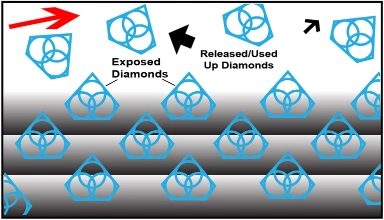
Sharpest And Finest Quality Diamonds
The newly exposed diamonds don’t effect diamonds already working on the material. Unlike many other diamond bonds, diamonds in a SMART CUT® Bond remains sharp and grow sharper with each cut, prolonging product life and consistent performance.
Step 2
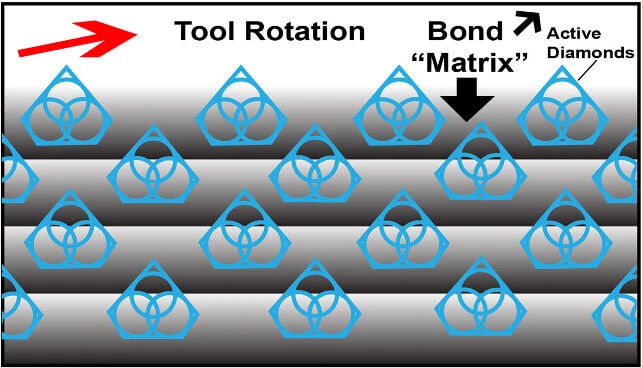
Diamonds or CBN Crystals
Diamonds or CBN Crystals are activated only at the exposed layer. As Bond Matrix layer begin to wear out, diamonds in a new Bond Matrix layer are immediately activated, substituting the already used up diamond layer. The SMART CUT® Diamond Hybrid Bond makes sure every diamond is in the right place and at the right time, working where you need it most.
Step 3
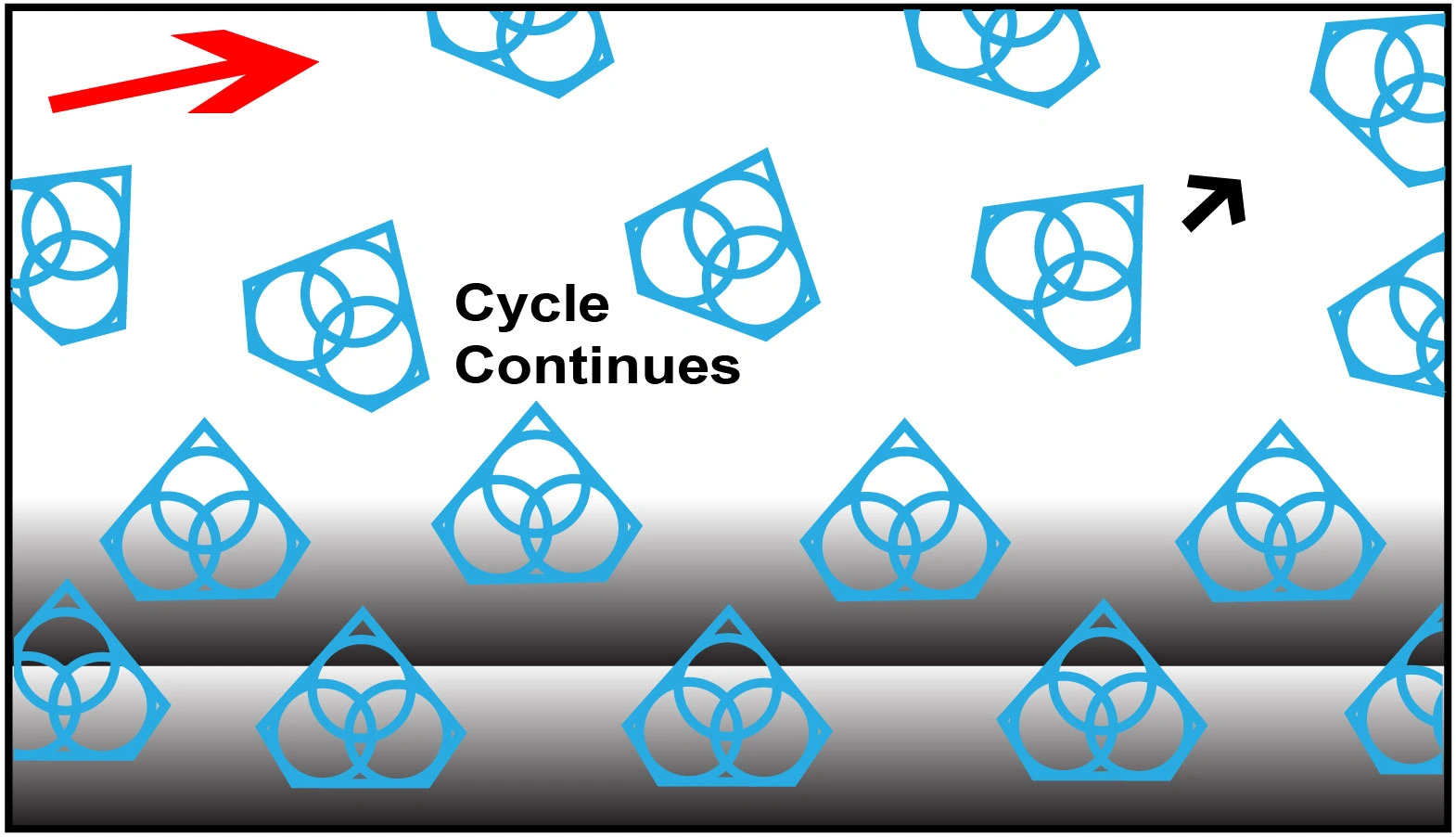
Advanced Formulated Open Diamond Bond Design
This advanced formulated open diamond bond design insures minimal chipping, fast cut, constant speed of cut, minimal cutting noise, and most important of all, consistent performance.

Faster & Freer Action
Diamond drills made utilizing SMART CUT technology are much more aggressive than your conventional drills. They can drill faster, while still leaving behind a smooth finish free of material deformation.
Longer Life
In most cases tools manufactured utilizing SMART CUT technology, will outlast other conventional Diamond Core Bits SMART CUT diamond & CBN tools are more sturdy than tools manufactured with conventional technologies. They are capable to retain their form and bond configuration all the way through the tools life.


More Consistent Performance
SMART CUT Diamond Core Bits are produced using advanced technology Unlike Many Other Core Bits they wear evenly, and are known for their consistency. You will get consistent cutting speed, and overall consistent performance, with minimum amount of dressing even on the hardest to cut materials
Manufactured Using The Highest Quality Raw Materials
Only the highest quality synthetic diamonds and raw materials are used in the manufacturing process. The highest quality standards and product consistency is maintained, using sophisticated inspection and measurement equipment.


Best Performance & Value on the Market
SMART CUT® Dry Diamond Core Bits are the best investment you can make! Although they may cost more than Dry Diamond Core Bits They will more than pay for themselves in terms of overall performance and provide best Return on Investment.
DIMOND CORE BIT FOR CONSTRUCTION
Custom Manufacturing Capabilities







In addition to the standard SMART CUT series Diamond Core Bits typically available from stock. We can produce large variety of custom diamond Core Bits and tools per your specification or drawing
- Almost any diameter
- Almost any (anygle/radius) Segments
- Almost Any Wall/kerf Thickness
- Custom drill lengths
- Custom Mounting Types
- Almost any diamond size
Why Choose Us?
Optimize your application to ultimate level of efficiency

- Unmatched Selection For Many Applications
- Unmatched Technical Support & Expertise
- Superior Quality & Consistency
- Super Technology & innovation
- Immediate Worldwide Delivery
- American Based Manufacturer
-
Custom
Manufacturing - Better Value manufacturer Direct Price
Related Products
SMART CUT® 140DM Diamond Core Bits / Drill Bits for Concrete & Allied Materials (wet only)
Dry Diamond Core Bits for Masonry & Concrete (dry/wet)
SMART CUT® DIAMOND CORE BITS
SINTERED (METAL BOND) SUPER PREMIUM QUALITY – Pointed Segments
Designed for Drilling Hard Materials such as full range of Rocks (granite, marble, quartz, flagstone, sandstone, onyx, amethyst, travertine, garnet. Will also work (agate, jasper, jade, petrified wood, and similar minerals). What sets these core bits apart is high grade of diamond used & advanced bond formulation designed for Hard Material. The diamond segment is shaped in a U form, has double-pointed tips penetrate quickly and hold a straight drilling path to reduce side drag, and also increases coolant flow to reduce heat and removal slurry more efficiently. Diamond Segments are Laser Welded to precision machined steel body by automatic process that is very highly consistent and error free. Must use with Mineral Oil or water soluble coolant to drill these harder materials. Also very highly recommended to use with water swivel adapter to run high pressure of coolant through center of drill and frequent dressing for these harder materials.Recently Viewed Products

ARE YOU USING RIGHT DIAMOND CORE BITS
FOR YOUR APPLICATION?
LET US
HELP YOU
HAVING ISSUES WITH
YOUR CURRENT DIAMOND CORE BITS?
02
Jun
Diamond Core Bit Ultimate Guide
Diamond Core Bits for Concrete & Construction are available in countless of specifications. Diamond core bits, known for their unmatched durability and cutting ability, are a necessity for professionals needing to drill through reinforced concrete,...
02
Jun
Concrete Drilling Metrics – Optimizing your Diamond Core Bit
Recommendations on speeds, feed rates and equipment to use to obtain best return on investment for using diamond core bits for drilling concrete and related materials
Share this Article with Friend or...
02
Jun
Select right Diamond Drill for your application
Learn important diamond drill methodology. understand diamond drill specifications and their differences Selecting the right Diamond Drills/Bits for your application is key to obtaining desired diamond drilling results. Using the Right Diamond Drill will...
02
Jun
How to Properly Use Precision Diamond Drills
Step by step guide on how to properly use and care for your diamond drills. Selecting the right diamond drill/diamond drill bit parameters, often involves a trial and error process. Many which can be avoided...
02
Jun
Diamond Drills Guide
Diamond are used across large variety of industries and applications. This guide explores the wide range of diamond drill types, including hollow core drills designed for removing a cylindrical core, non-core formation drills that grind...
02
Jun
Optimizing your Diamond Drilling Operation
There are numerous factors that influence the performance of diamond drills. Understanding these factors helps users select the appropriate diamond drill specifications for their specific applications, optimizing drilling operations to achieve maximum efficiency....
02
Jun
Selecting Right Drilling Equipment for your Application. What you features & functionality you should look for?
Share this Article with Friend or Colleague
There are hundreds or even thousands of different drilling equipment options. Selecting the right equipment for a specific application involves carefully considering several variables and attributes of the...
03
May
Diamond Core Drill & Drill Trouble Shooting Guide
Learn the most common problems most people have in using diamond drills. How to resolve them and avoid them in first place
https://ukam.com/wp-content/uploads/2024/07/diamond-drill-troublehsooting-guide.mp4
Troubleshooting Drilling Problems
Having issues with your diamond drilling operation? This Illustrated Guide...
09
Sep
Understanding & Calculating Return on Investment for Diamond Core Drills & Other Tools
The term "ROI" (Return On Investment) is widely used across industries, often interpreted differently depending on the context. However, few truly understand what ROI represents and its specific implications, particularly in the context of diamond...
09
Sep
Understanding Tradeoffs – Searching for Perfect Diamond Drill & Tool
Choosing the right diamond drill or tool can significantly impact efficiency, cost, and quality. However, this is not a simple and clear-cut process. Selecting the optimal drill or tool involves navigating a complex landscape of...
20
Sep
Diamond Drill Terminology Guide – Key Terms Explained for Precision Drilling
How to fine tune each of these variables to improve and optimize your drilling operation in the success of your diamond drilling operation
Share this Article with Friend or Colleague
DIAMOND DRILL /...
- Unmatched Selection For Many Applications
- Superior Quality & Consistency
- Immediate Worldwide Delivery
- Technical Support & Expertise
- American Based Manufacturer


- Different Product
- Different Technology
- Different Company
- Expect MORE from your tools
Let Us HELP You!
Subscribe To Our Newsletter
Signup for email offers, updates, and more
Contact Us
- 25205 & 25201 Avenue Tibbits Valencia CA 91355 USA
-
Phone : (661) 257-2288
FAX : (661) 257 -3833 - lel@ukam.com

UKAM Industrial Superhard Tools is a U.S. High Technology, Specialty Diamond Tool & Equipment manufacturer. We specialize in producing ultra thin, high precision cutting blades, precision cutting machines diamond drills, diamond micro tools, standard & custom advanced industrial diamond tools and consumables.
- 25205 & 25201 Avenue Tibbits Valencia CA 91355 USA
-
Phone : (661) 257-2288
FAX : (661) 257 -3833 - lel@ukam.com
- 25205 & 25201 Avenue Tibbits Valencia CA 91355 USA
-
Phone : (661) 257-2288
FAX : (661) 257 -3833 - lel@ukam.com
DIAMOND TOOLS BY BOND
EQUIPMENT
KNOWLEDGE CENTER
OUR PRODUCTS
COMPANY
CUSTOMER SERVICE
Shipping Methods

Safe & Secure Payments

© Copyright 1990-2025. UKAM Industrial Superhard Tools – Terms of Use










